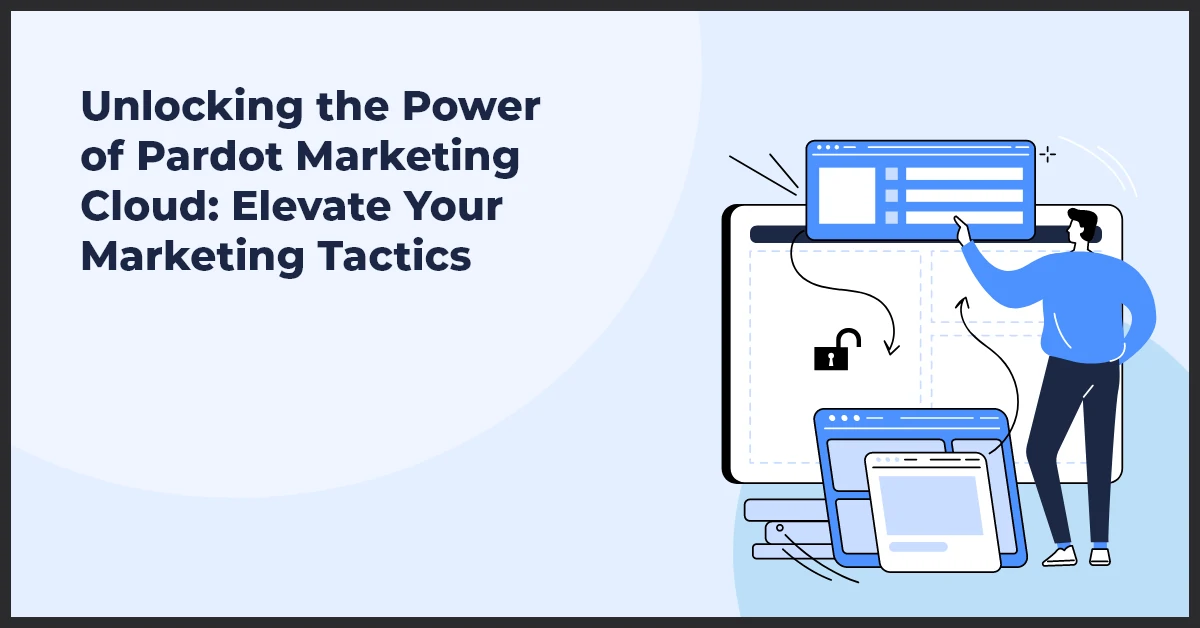How A/B Testing Can Help Perfect Your Pardot Emails

Published on: October 14, 2021
Updated on: July 08, 2024
762 Views
- Pardot
11 min read
Because email communications are such a vital element of a marketing plan, it's critical to keep your emails in tip-top shape. The following Pardot official statement is the best guide for your campaign.
“After all, successful email campaigns aren’t just about your email template”.
Then, what is it all about?
It’s about creating impactful and engaging content that your audience connects with. The question is, how do you know what content your audience is going to find engaging? Optimizing Pardot emails with A/B Testing functionality is a great way to identify which content your audience engages with the most as well as constantly enhance your campaigns.
Moreover, with the recent announcements, Pardot's email capabilities have received a significant boost:
- Beginning in September/ October 2021, all Pardot editions will have more drag-and-drop capabilities.
- Marketers can push emails built-in Lightning Email Builder for use in Engagement Studio programs.
- You can add custom components for the Email Content Builder.
Pardot email marketing
Pardot email marketing is a powerful tool that gives marketing teams the ability to deliver personalized experiences to thousands of prospects at once. Pardot's automation capabilities allow you to send messages based on customer behavior and engagement, making your communications more targeted and effective.
Creating responsive email templates is essential for any Pardot email marketing campaign. A template that looks great on a desktop computer might be unreadable on a mobile device. With Pardot, you can use the lightning email builder or the classic builder to design and customize beautiful emails that will look great on any device.
There are different types of Pardot emails, each with its unique capabilities. Engagement studio emails are great for nurturing leads by delivering a sequence of targeted messages based on a customer's behavior. Drip programs, on the other hand, are ideal for sending out a series of automated emails on a timed schedule. One-to-one emails are personalized messages sent to individual prospects, while list emails are sent to a group of recipients based on specific criteria. Lastly, autoresponders are automated emails that are triggered by a customer's behavior, such as filling out a form.
To get the most out of your Pardot email marketing campaigns, it is important to know the capabilities of each type of email. This way, you can choose the most appropriate email type to achieve your marketing goals. By incorporating Pardot email marketing into your overall digital marketing strategy, you can increase your click-through and conversion rates while creating a more engaging customer experience.
In conclusion, Pardot email marketing is an essential tool for any marketer looking to deliver personalized experiences to their prospects. Utilizing responsive templates and the various types of Pardot emails such as engagement studio, drip programs, one-to-one emails, list emails, and autoresponders, can help you create effective and engaging marketing campaigns that deliver results.
Types of Pardot emails
Pardot offers a variety of email types to help businesses effectively communicate with their prospects and customers. These include one-to-one emails, email blasts, drip campaigns, and engagement programs.
One-to-one emails are perfect for sales reps who want to send an individualized message directly to a prospect. With Pardot, they can compose and send an email from their own email address or send it through Pardot's email system. This type of email is ideal for building personalized relationships, providing targeted information, or following up on a specific conversation.
Email blasts, on the other hand, are messages that are sent to everyone on an email list at once. This type of email is useful for reaching a wide audience in a short amount of time. Whether you're promoting a new product or announcing a sale, an email blast can be an effective way to quickly communicate with a large group.
Drip campaigns are a series of automated emails that are sent to a prospect over a period of time. This type of email is used to nurture leads and guide them through the customer journey. Pardot's drip campaigns feature allows businesses to send a series of emails that are triggered by specific actions or behaviors.
Lastly, Pardot's engagement programs combine the power of one-to-one emails, email blasts, and drip campaigns. This type of email is designed to nurture prospects through a combination of communication methods. With completion actions, businesses can trigger a series of emails based on the behavior of a prospect or customer, helping to guide them toward a sale.
In conclusion, Pardot offers several types of emails to help businesses communicate effectively with their target audience. From one-to-one emails to engagement programs, businesses can choose the right type of email to meet their needs and drive results.
Why Use A/B Testing?
A/B testing is an indispensable tool for Pardot email marketers. It allows marketing teams to test different variations of their campaigns to determine what works best and what doesn't. By conducting A/B testing, marketers can make data-driven decisions that boost engagement rates, open rates, and ultimately, conversion rates.
One of the advantages of using A/B testing in Pardot email marketing is the ability to gather valuable data insights. With such insights, marketing teams can optimize their campaigns and create more effective messaging that resonates with their audience. These data insights can reveal important information regarding the preferences of email recipients, such as the type of subject lines that generate higher open rates, the ideal time and day to send emails, and the most effective styles of email content.
By using A/B testing, marketing teams can also create customized email campaigns. This is because the insights gained from testing different variations can be leveraged to tailor future campaigns according to the preferences and behavior of specific segments of their audience. This approach can help organizations connect with their audience in a more personalized way, thereby increasing engagement rates and driving better results.
Another advantage of A/B testing is the opportunity to identify top performing campaigns. This aspect is particularly important because it ensures that marketing teams are continually optimizing their campaigns and improving their email marketing results. By testing different variations such as email subject lines, email content, and action buttons, marketers can identify the top performers and use these insights in future campaigns.
In sum, using A/B testing in Pardot email marketing is crucial to gathering data insights, creating customized campaigns, and continually optimizing campaigns to achieve better results. By leveraging these insights over time, marketing teams can improve engagement rates, open rates, and ultimately, conversion rates. Thus, A/B testing is an essential tool in the Pardot email marketer's toolkit.
How to do email ab testing
Email A/B testing involves creating two or more versions of an email and sending them to different segments of your audience to determine which version performs better. To start, identify a specific element of your email that you want to test, such as the subject line, sender name, call-to-action button, or content layout. Then, divide your target audience into separate groups, ensuring they are similar in size and demographics. Craft two or more variations of the email, changing only the element you want to test while keeping the rest of the content consistent.
Next, select an A/B testing tool or use an email marketing platform that provides this feature. Set up the test by creating multiple email versions, assigning a percentage of your audience to each variant, and scheduling the delivery time. Ensure the emails are sent simultaneously to minimize any external factors that may influence the results.
Once the emails are sent, monitor and measure the performance metrics such as open rates, click-through rates, conversion rates, and engagement. Analyze the data to identify the version that achieved the desired outcome or had the highest impact on your campaign objectives. Use the insights gained from the A/B test to optimize future email campaigns and implement the winning elements in your regular email strategy.
Remember, A/B testing is an iterative process, so continue experimenting with different elements to refine your email marketing efforts and improve your overall results.
Pardot Best Practices — A/B Testing
A/B testing is an essential practice in improving the effectiveness of Pardot emails. It allows marketers to compare two versions of an email and identify which one performs better in terms of open rates, click-through rates, and conversion rates. This data-driven approach helps optimize email campaigns, resulting in higher engagement and improved ROI.
In the context of Pardot, A/B testing involves creating two variations of an email, each with a single difference, such as subject line, call-to-action placement, or email design. The email is then sent to a sample size of the target audience, and performance metrics are analyzed to determine the winning version.
To conduct an A/B test for Pardot emails, follow these steps:
1. Identify the goal: Determine what you want to measure and improve, such as open rates or click-through rates.
2. Define variables: Choose one element to test, such as subject line or email design, and create two versions with a single difference.
3. Set sample size: Determine the percentage of your email list that will receive each version of the email. A larger sample size ensures more reliable results.
4. Analyze the results: Monitor key metrics like open rates, click-through rates, and conversion rates to identify the winning version.
Tips for optimizing the testing process:
Tips:
- Keep it simple: Test one variable at a time to isolate the impact and understand its effect.
- Test a significant sample size: Ensure your sample size is large enough to achieve statistical significance and reliable results.
- Test consistently: Run A/B tests consistently to continuously improve your email marketing strategies.
By leveraging A/B testing in Pardot emails, marketers can make data-driven decisions, optimize future campaigns, and deliver more personalized and engaging content to their target audience.
What is Email A/B Testing?
A/B testing, often known as split testing, is a method of comparing two email versions to see which one performs the best in terms of your selected performance indicator, usually opens or clicks.
You create two email versions and send them to a portion of your email list. Set a time limit for the split test to run, and then send the winning email version to the rest of your list at the end of the contest.
You can enable this functionality under the Basic Information tab of your List emails.
Step 1
Select whatever section of the email you want to test. The most commonly tested sections are:
Email Subject: Most people use the subject line to decide whether to open the email or not. Stimulus to do something in order to achieve an aim, also known as a call to action.
Associated Graphics: You can A/B test the images you use in the email to see which color or graphic performs better.
Personalization: Personalizing content is key to resonating with your audience but you must test and find which way is better to connect with your audience’s emotions.
Headline: When someone opens an email, this is the first thing they see. Making the headline a link is one great thing to experiment with.
Sender email address: An often overlooked section for A/B testing is to experiment with who's sending the emails and where they're coming from. Sending a tiny part of your emails to a new “from” name and address to see whether it affects your stats is a good idea.
Patience is the key with your A/B testing. It's crucial to test only one thing at a time, as testing numerous things can mask whatever change actually improved things.
Step 2
Decide how much of your list you want to focus on. Would you like to test your full email list or just a portion of it? To improve the accuracy of your results, it's best to test the complete list. Otherwise, rather than a statistically significant boost, the winning version could be a product of chance. But it depends on your marketing and potential customer base clarity.
Step 3
Have well-defined benchmarks. Examine your previous performance and set a target using historical data. For example, if your monthly newsletter's typical open rate is 20%, you may set a goal for your A/B test of 25% open rate.
Step 4
Deploy and optimize Run your test, and once you've found a winner, that's the new version you'll have to beat. Keep optimizing and perfecting over a period of time and harness the benefits of automation.
We have learned here how to strategize your Pardot A/B testing campaign. However, the testing should be done with a sizable database so that you cover all the aspects of the test. In case of any specific requirement, you should not hesitate in taking help from an expert consultant.
At Growth Natives, our Pardot certified professionals have worked with several customers to automate and optimize their campaigns. We will be happy to help you. You can write to us at info@growthnatives.com.
Happy Marketing!
Frequently Asked Questions
A/B testing, also known as split testing, involves sending two variations of an email to different segments of your audience to determine which performs better. In the context of Pardot emails, it allows you to test different elements such as subject lines, sender names, email content, and call-to-action buttons to optimize your email campaigns.
A/B testing provides Pardot users with valuable insights into the preferences and behaviors of their audience. By testing different elements of their emails, users can identify which variations resonate best with their audience and improve the effectiveness of their email campaigns.
Pardot users can test various elements of their emails, including subject lines, sender names, preheader text, email content, images, calls-to-action, button colors, and send times. Testing these elements allows users to determine which combination drives the most engagement and conversions.
Setting up an A/B test for Pardot emails involves creating multiple variations of the email with different elements (e.g., subject lines, content) and specifying the test criteria and audience segments within the Pardot email builder. Pardot then randomly assigns different versions of the email to segments of the audience, tracks their performance, and provides insights into which variation performs better.



